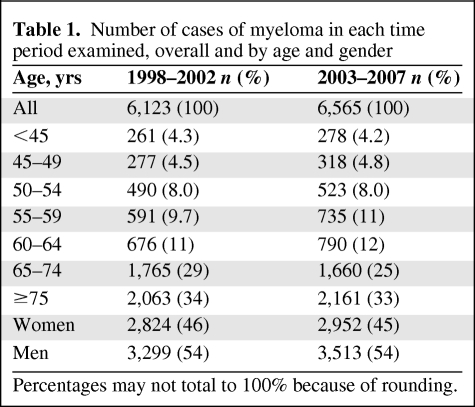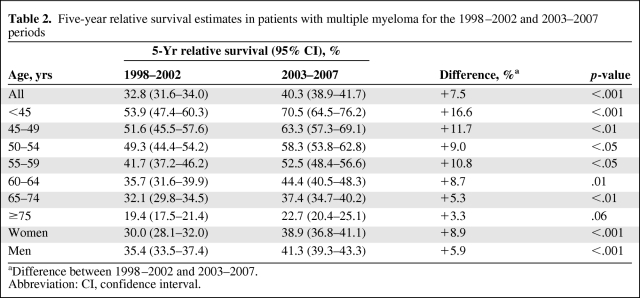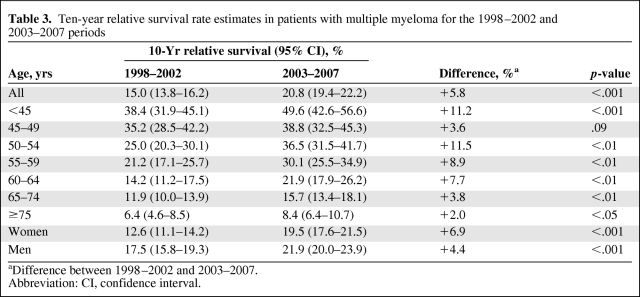Changes in the 5- and 10-year relative survival rates of multiple myeloma patients from 1998–2002 to 2003–2007 were estimated using period analysis to examine data from the Surveillance, Epidemiology, and End Results database. Survival outcomes continue to improve for these individuals and now extend to older patients as well.
Abstract
Background.
Treatment of multiple myeloma has changed significantly over the past several years with clinical trials reporting superior survival results using newer agents. Previous work has shown that the survival rate has improved for younger, but not older, patients with myeloma. Here, we update survival estimates for patients with myeloma in the early 21st century to determine whether continued improvement can be seen on a population level and whether or not it now extends to older patients.
Methods.
Using period analysis to examine data from the Surveillance, Epidemiology, and End Results database, we estimate changes in the 5- and 10-year relative survival rates (RSRs) from 1998–2002 to 2003–2007.
Results.
The 5- and 10-year RSRs have improved for patients with myeloma overall, from 32.8% and 15% in 1998–2002 to 40.3% and 20.8%, respectively, in 2003–2007. The greatest improvements were observed for patients aged 15–44 years, with 5- and 10-year RSRs reaching >70% and ∼50%, respectively, but improvements were also seen for patients aged >70 years.
Conclusion.
Overall, survival continues to improve for patients with myeloma, including older patients, suggesting that newer treatment options continue to make a population-wide impact.
Background
Multiple myeloma (MM) is a chronic, currently incurable, malignancy of the plasma cells. In 2010, an estimated 20,180 cases of myeloma and 10,650 deaths were expected in the U.S. [1]. Recent advances in therapy have resulted in better survival outcomes both in clinical trials and on a population basis [2–4]. We previously examined changes in the survival rate of patients with MM through the years 2002–2004 using period analysis and demonstrated that survival improved between 1990–1992 and 2002–2004 for younger patients (age <60 years), although no improvement in the survival rate was seen for older patients [2]. Here, we update those results by specifically addressing the most recent trends from 1998–2002 to 2003–2007 for patients in the Surveillance, Epidemiology, and End Results (SEER) database.
Methods
Database
All data presented in this paper are derived from the 1973–2008 limited-use database of the SEER program of the U.S. National Cancer Institute issued in April 2011 [5]. We used data included in the 1973–2008 SEER9 database, which are from population-based cancer registries in Connecticut, New Mexico, Utah, Iowa, Hawaii, Atlanta, Detroit, Seattle–Puget Sound, and San Francisco–Oakland and together cover a population of ∼30 million people. Geographic areas were selected for inclusion in the SEER program based on their ability to operate and maintain a high-quality population-based cancer reporting system and for their epidemiologically significant population subgroups.
Overall, 36,459 patients aged ≥15 years with a first diagnosis of MM (and no previous cancer diagnosis) in 1973–2007, who had been followed for vital status until the end of 2008, were included in the dataset. Data from the year 2008 were not included in this analysis because internal evidence suggested that there may be some mortality data missing from the most recent year and this might result in a falsely elevated survival rate for 2008. Specifically, a single-year analysis of the survival rate of MM patients showed an improbably large increase for the year 2008 and a single-year analysis of the survival rate for pancreatic cancer patients, a condition for which little progress has been made over the past year, demonstrated an apparent increase in the survival rate as well. Taken together, these findings strongly suggest that the survival data for 2008 are not complete. After exclusion of 78 patients (0.2%) who were reported by autopsy only and 602 patients (1.7%) who were reported by death certificate only, there remained 35,779 patients (98.1%) for the survival analysis.
Statistical Analysis
The 5-year survival rate was calculated for the calendar periods 1998–2002 and 2003–2007 using period analysis methodology [6, 7]. Furthermore, we tested for statistical significance of trends in the 5- and 10-year survival rates between 1998–2002 and 2003–2007 using a recently described modeling approach [8]. Survival was examined by age group (15–44 years, 45–49 years, 50–54 years, 55–59 years, 60–64 years, 65–74 years, and ≥75 years) and by gender as well as overall. Ninety-five percent confidence intervals for the survival estimates were calculated using Rothman's method [9].
According to standard practice in population-based cancer survival analysis, relative survival rates were calculated. The relative survival rate reflects the survival rate of cancer patients compared with the survival rate of the general population. It is calculated as the ratio of the absolute survival rate of cancer patients divided by the expected survival rate of a group of persons of the corresponding sex, age, and race in the general population [10, 11]. Estimates of the expected survival rate were derived according to the Ederer II method [12] using U.S. sex-, age-, and race-specific life tables [13].
Results
The numbers of cases identified in the SEER database for the relevant periods are listed in Table 1. The number of cases and age and gender distributions were relatively stable over the time periods examined. The number of cases was >250 for each category.
Table 1.
Number of cases of myeloma in each time period examined, overall and by age and gender
Percentages may not total to 100% because of rounding.
The 5-year relative survival rate improved for patients with MM overall and for each age group examined when the years 2003–2007 were compared with 1998–2002 (Table 2). The greatest improvement (+16.6 percentage units) was seen for patients aged <45 years, but improvements in the survival rate were seen for all ages. The change in the survival rate reached statistical significance at an α of 0.05 for every age group except those aged ≥75 years. Statistically significant improvements in survival expectations were observed for both genders, with a slightly greater improvement observed for women than for men (+8.9 and +5.9 percentage units, respectively).
Table 2.
Five-year relative survival estimates in patients with multiple myeloma for the 1998–2002 and 2003–2007 periods
aDifference between 1998–2002 and 2003–2007.
Abbreviation: CI, confidence interval.
The 10-year relative survival rate also improved for patients overall and for each age group and both genders (Table 3). In contrast to the 5-year survival rate, the greatest improvement (+11.5 percentage units) was seen in the 50–54 years age group, although a large improvement (+11.2 percentage units) was seen for the youngest age group as well. The increase was statistically significant at an α of 0.05 for every age group except for those aged 45–49 years and including those aged ≥75 years. Again, improvement was seen for both men and women, with a slightly greater improvement for women.
Table 3.
Ten-year relative survival rate estimates in patients with multiple myeloma for the 1998–2002 and 2003–2007 periods
aDifference between 1998–2002 and 2003–2007.
Abbreviation: CI, confidence interval.
Discussion
The 5- and 10-year survival rates compare favorably with the survival rates estimated in our previous papers [2, 14]. A comparison with our previous paper using model-based projection to predict survival rates for 2006–2010 shows that the survival rate in 2003–2007 is comparable with that estimated in this paper for 2006–2010, suggesting that the rate of increase in survival is accelerating over time. Additionally, unlike in analysis of the SEER data in previous years, the increase in survival times now extends to older adults.
Therapeutic options for MM have changed radically in the past several years. Several unconventional agents, including the immunomodulators thalidomide [3] and lenalidomide [15] and the proteosome inhibitor bortezomib [4], have been shown to produce longer survival times in patients with MM in clinical trials. In particular, although in the past treatment options for MM were severely limited by the lack of availability of stem cell transplant for patients aged >65 years, several clinical trials have confirmed that the newer agents also lead to longer survival times in older patients [3, 16]. In previous publications, we demonstrated that the survival of patients with MM is improving over time, particularly for younger patients [2]. The current results suggest that this trend is continuing and that older patients are beginning to see an improvement in their survival probability as well.
Other potential reasons for the changes observed may be related to changes in the diagnosis of MM. Although there is no official screening test for MM, the use of screening labs such as the CBC and comprehensive metabolic profile in asymptomatic patients along with greater patient and physician awareness of myeloma as part of the differential diagnosis of hypercalcemia, anemia, renal failure, and hyperproteinemia may have increased the diagnosis of MM at earlier stages. However, because no clear changes in the use of screening labs in asymptomatic individuals have occurred in the last decade, this is unlikely to be a major cause of the change in the survival rate observed.
In interpreting our results, several limitations must be considered. First, the SEER database does not contain information concerning the use of chemotherapy, and therefore no direct assessment of a potential link between changes in therapy and superior survival results can be made. Additionally, even with use of the large SEER database, the confidence intervals for age-specific survival rate estimates were large, limiting our ability to determine whether some of the improvements seen were true increases in the survival rate or random fluctuations.
In summary, our results suggest major ongoing improvement in the survival probability of patients with MM. Improvement is strongest among the youngest MM patients, whose 5-year survival rate is now >70%. Notably, however, improvement is now also beginning to extend to older patients. Given the recent introduction of new treatment options for MM patients and the ongoing improvement in our understanding of how best to use these treatment options, further improvements may be expected over the next decade.
Footnotes
- (C/A)
- consulting/advisory relationship
- (RF)
- Research funding
- (E)
- Employment
- (H)
- Honoraria received
- (OI)
- Ownership interests
- (IP)
- Intellectual property rights/inventor/patent holder
Author Contributions
Conception/Design: Hermann Brenner, Dianne Pulte
Data analysis and interpretation: Hermann Brenner, Dianne Pulte, Adam Gondos
Manuscript writing: Hermann Brenner, Dianne Pulte, Adam Gondos
Final approval of manuscript: Hermann Brenner, Dianne Pulte, Adam Gondos
References
- 1.Jemal A, Siegel R, Xu J, et al. Cancer statistics, 2010. CA Cancer J Clin. 2010;60:277–300. doi: 10.3322/caac.20073. [DOI] [PubMed] [Google Scholar]
- 2.Brenner H, Gondos A, Pulte D. Recent major improvement in long-term survival of younger patients with multiple myeloma. Blood. 2008;111:2521–2526. doi: 10.1182/blood-2007-08-104984. [DOI] [PubMed] [Google Scholar]
- 3.Wijermans P, Schaafsma M, Termorshuizen F, et al. Phase III study of the value of thalidomide added to melphelan plus prednisone in elderly patients with newly diagnosed multiple myeloma: The HOVON 49 Study. J Clin Oncol. 2010;28:3160–3166. doi: 10.1200/JCO.2009.26.1610. [DOI] [PubMed] [Google Scholar]
- 4.San Miguel JF, Schlag R, Khuageva NK, et al. Bortezomib plus melphalan and prednisone for initial treatment of multiple myeloma. N Engl J Med. 2008;359:906–917. doi: 10.1056/NEJMoa0801479. [DOI] [PubMed] [Google Scholar]
- 5.DCCPS, Surveillance Research Program, Cancer Statistics Branch. Bethesda. MD: National Cancer Institute; 2011. [accessed September 28, 2011]. Surveillance, Epidemiology, and End Results (SEER) Program Limited Use Data (1973–2008). Released April, 2011 based on November 2010 submission. Available at www.seer.cancer.gov. [Google Scholar]
- 6.Brenner H, Gefeller O. An alternative approach to monitoring cancer patient survival. Cancer. 1996;78:2004–2010. [PubMed] [Google Scholar]
- 7.Brenner H, Hakulinen T. Up-to-date long-term survival curves of patients with cancer by period analysis. J Clin Oncol. 2002;20:826–832. doi: 10.1200/JCO.2002.20.3.826. [DOI] [PubMed] [Google Scholar]
- 8.Brenner H, Hakulinen T. Up-to-date and precise estimates of cancer patient survival: Model-based period analysis. Am J Epidemiol. 2006;164:689–696. doi: 10.1093/aje/kwj243. [DOI] [PubMed] [Google Scholar]
- 9.Rothman KJ. Estimation of confidence limits for the cumulative probability of survival in life table analysis. J Chronic Dis. 1978;31:557–560. doi: 10.1016/0021-9681(78)90043-7. [DOI] [PubMed] [Google Scholar]
- 10.Ederer F, Axtell LM, Cutler SJ. The relative survival rate: A statistical methodology. Natl Cancer Inst Monogr. 1961;6:101–121. [PubMed] [Google Scholar]
- 11.Henson DE, Ries LA. The relative survival rate. Cancer. 1995;76:1687–1688. doi: 10.1002/1097-0142(19951115)76:10<1687::aid-cncr2820761002>3.0.co;2-i. [DOI] [PubMed] [Google Scholar]
- 12.Ederer F, Heise H. Methodological Note No. 10. Bethesda, MD: National Cancer Institute; 1959. Instructions to IBM 650 Programmers in Processing Survival Computations. [Google Scholar]
- 13.Arias E. United States life tables, 2000. Natl Vital Stat Rep. 2002;51:1–38. [PubMed] [Google Scholar]
- 14.Brenner H, Gondos A, Pulte D. Expected long-term survival of patients diagnosed with multiple myeloma 2006–2010. Haematologica. 2009;94:270–275. doi: 10.3324/haematol.13782. [DOI] [PMC free article] [PubMed] [Google Scholar]
- 15.Dimopoulos M, Spencer A, Attal M, et al. Lenalidomide plus dexamethasone for relapsed or refractory multiple myeloma. N Engl J Med. 2009;361:544. doi: 10.1056/NEJMoa070594. [DOI] [PubMed] [Google Scholar]
- 16.Hulin C, Facon T, Rodon P, et al. Efficacy of melphalan and prednisone plus thalidomide in patients older than 75 years with newly diagnosed multiple myeloma: IFM 01/01 trial. J Clin Oncol. 2009;27:3664–3670. doi: 10.1200/JCO.2008.21.0948. [DOI] [PubMed] [Google Scholar]





